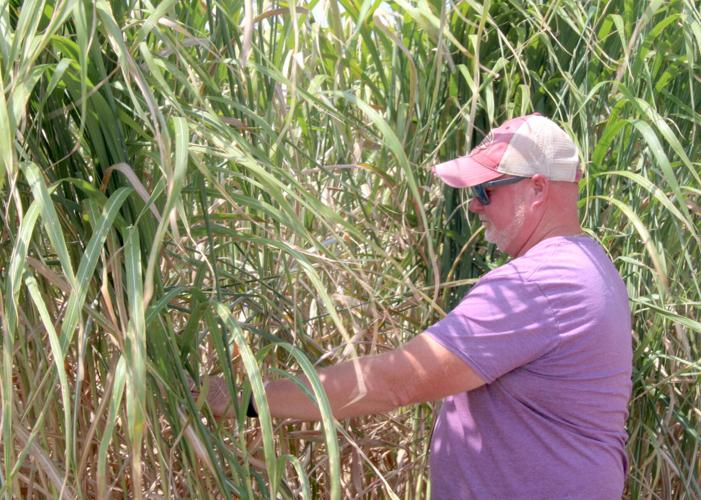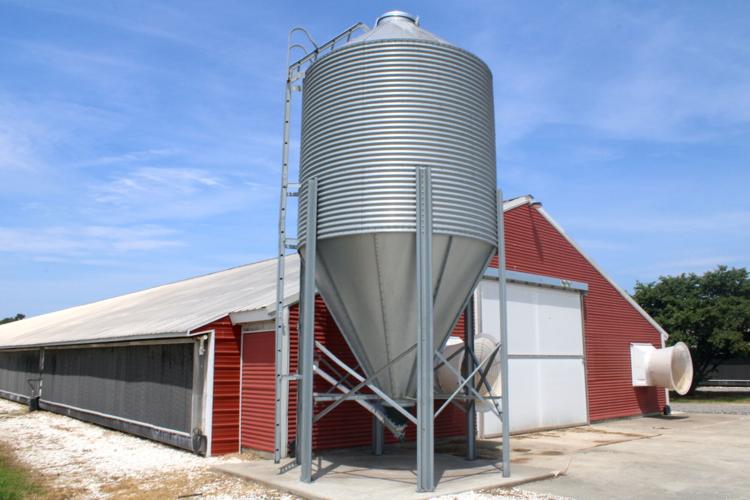RIDGELY — Over a decade ago, Dave Tribbett had a hunch, and it centered around a 10-to-12-foot tall species of grass — giant miscanthus.
Owner of Twin Maples Farms in Ridgely, Tribbett felt it could be used as alternative bedding in his poultry houses. The reception was ho-hum for the lesser-known crop.
“I couldn’t talk anybody into planting this stuff,” Tribbett said. “Nobody knew anything about it.”
He started by planting miscanthus on typically less successful areas, such as woodlines and ditches on his property. Once applied as chicken bedding, Tribbett noticed improvements to his chickens.
Tribbett has now planted hundreds of acres of the crop, working with industry leaders up and down the Eastern Shore to see its benefits. He works with Mountaire Farms to provide poultry farmers with the grass.
Mountaire communications director Catherine Bassett said “it’s a great alternative to wood shavings because fewer trees need to be cut down.” Over half of farms that house Mountaire chickens use miscanthus bedding.
Through partnerships with Mountaire, U.S. Geological Survey, North Carolina-based AGGrowTech and the University of Maryland, among others, Tribbett feels miscanthus has been validated as a successful alternative for farmers. The USDA partners with Tribbett and industry leaders to test and assess the crop’s benefits and risks on soil and the environment.
“I’ve accomplished my goal of proving it was a crop,” he said. “I’ve got the right people to check off this bucket list … and now it’s building infrastructure to be able to process this crop, allowing other farmers to divert some of their farmland that’s not as productive.”
THE CROPA “demanding crop,” miscanthus grass is harvested in the winter and grows from spring to the fall before it frosts over. It is known as a perennial grass since it doesn’t require replanting every year.
While planting costs can be around $1,200 to $1,500 an acre, Tribbett says, the long-term savings for a farmer are significant.
Sarah Hirsh, an agriculture agent at the University of Maryland, is involved in miscanthus research. Giant miscanthus grass, which is the variety found on Tribbett’s farm, isn’t considered dangerously invasive, she said.
“Some varieties of miscanthus are invasive,” Hirsh said. “But the giant miscanthus, it’s actually like a hybrid. … That makes it sterile like seedless watermelons. It can’t reproduce by seed.”
Through a Sustainable Agriculture Research and Education grant, Hirsh and the university worked with a Dorchester County farmer to plant the crop on 20 acres — a “marginal” farm, as Hirsh called it, compared to larger farmland such as Tribbett’s.
Hirsh said while “the field was salty, way beyond the levels that crops like corn or soybean would tolerate,” the miscanthus grass withstood those conditions. The university collected yields of the crop for two years and an increase from 2.8 tons per acre to 4.8 tons.
Working with other local farmers is a goal for the Twin Maples owner, who hasn’t been hesitant to “open his books” and share what’s worked. Tribbett hopes cost-shares can help small farmers begin growing miscanthus.
“That’s really the next kind of hurdle,” Hirsh said. “ … How can we make this a viable crop in the context of these marginal fields?”
MISCANTHUS LEAVESNot long after Tribbett confirmed its viability as bedding for his chicken houses, he found the giant miscanthus could serve as a feedstock for Mid-Atlantic Organic Resource Company, Tribbett’s compost business.
Once harvested, Tribbett has used miscanthus grass leaves in the company’s compost, which also includes hatchery and grain waste. It’s created a fertilizer that he applies to his own farm as well as selling to fellow farmers around the area.
“The result is an even-keel fertilizer that’s not elevated in phosphorus levels,” he said.
Tribbett emphasized the “closed loop” of business that this innovation has created, not just with his farm, but subcontractors on the Eastern Shore. The compost company currently employs 15 people, which could double to 30, as he works with AGGrowTech to create a bagging line for the crop by 2025.
“We are bringing work, we’re bringing jobs and we’re keeping it here on the Shore,” Tribbett said. “ ... It’ll be a good crop for Caroline County, the Shore (and) the state.”
Plus, it’s created industry partnerships that seek to take advantage of the crop’s help in filtering groundwater and reducing trucking emissions from typical bedding sources. Tribbett has worked with the Maryland Environmental Service and sat in meetings with the Environmental Protection Agency.
“It’s building a lot of momentum to bring organizations that have not traditionally worked together,” Tribbett said. “I guess it’s why it touches me so much. I’m proud of the chicken industry. I wouldn’t be here without the people that have worked with me throughout the years.”














(1) comment
The grasses are also quite beautiful. Thank you for helping the environment, chickens and farming
Welcome to the discussion.
Log In
Keep it Clean. Please avoid obscene, vulgar, lewd, racist or sexually-oriented language.
PLEASE TURN OFF YOUR CAPS LOCK.
Don't Threaten. Threats of harming another person will not be tolerated.
Be Truthful. Don't knowingly lie about anyone or anything.
Be Nice. No racism, sexism or any sort of -ism that is degrading to another person.
Be Proactive. Use the 'Report' link on each comment to let us know of abusive posts.
Share with Us. We'd love to hear eyewitness accounts, the history behind an article.